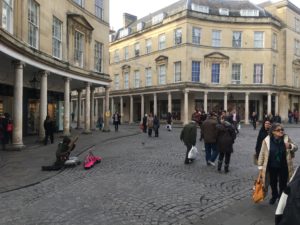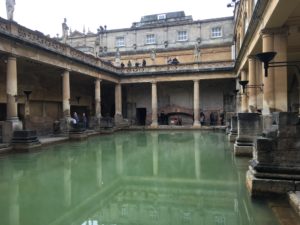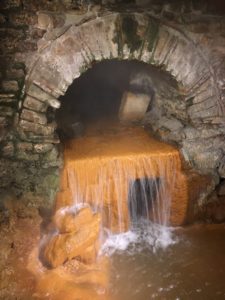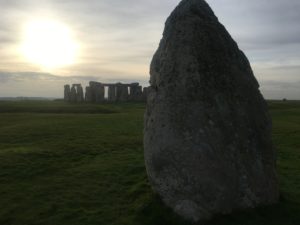“A straight line may be the shortest distance between two points, but it is by no means the most interesting.” -Jon Pertwee as Dr. Who

Something I always have to remind myself about driving in England is how much longer it takes to travel certain distances. For example, traveling from our Air B&B in Bourton-on-the-Water to the Roman Baths in Bath was a 54 mile distance that took well over an hour to drive. Likewise, from the baths to Stonehenge, 34 miles took well over 50 minutes. These are distances in the U.S. that wouldn’t take nearly as long, on account of England’s narrow and winding roads forcing us up and down steep slopes and dramatic grades—roads that have no shoulder, the edge squeezed right up against tall hedges and old stones walls—roads that also are sometimes so narrow that signs warn drivers that there may be “oncoming traffic in middle of road.” But this is all part of the charm of driving here, and it’s fantastic, and I wouldn’t have it any other way. (Although, I must admit that driving at night is mildly terrifying but exciting all the same.)

Today we navigated quite a few of these ridiculous roads, taking us all the way from Bourton-on-the-Water in the Cotswalds to Lytchett Matravers near the southern coast—152 miles in well over 3 hours. This distance made it a little difficult for us to fit everything into our day, but we managed it nonetheless. Although I did feel we had to rush through things a bit.
Our first stop of the day was the Roman Baths in Bath (but not before a stop at a lovely place called Bill’s where Aaron and I enjoyed a spectacular full English breakfast complete with black pudding and beans on toast while the others enjoyed pancakes and avocado eggs Florentine). I had previously visited the Roman Baths in 2014, and it was a real highlight of that year’s visit. It’s one of those locations that I would probably consistently award 4 stars out of 5, which means, of course, that I found it really quite wonderful and I’d maybe visit again one or two more times (which, indeed, I now have done). Whereas Shakespeare’s house I’d award a solid three out of five, as I’m glad I saw it but I probably won’t ever go back.

What might be a little disappointing to first-time guests of the baths is that much of what gets photographed (the large rectangular bath filled with steaming green water surrounded by statues of caesars and classical columns) was built up around the original foundations in the 19th century (probably to attract more tourists, I imagine). But this is all beside the point, as guests still have the opportunity to view much of the original foundation while learning about what life was like for Romans in England all that time ago (through a handheld audio tour that I highly recommend and that supplements all the display cases and plaques). This includes viewing artifacts from the time like a sculpture of Minerva’s head that was once fixed to an imposing statue of her entire body, and she would have been placed prominently near the altar of sacrifice. There are also quite a few fragments of the original structure that survive, and the museum has expertly arranged the fragments into where they might have originally been located, a modern image affixed to the wall filling in the gaps. Additionally, there are clear glass sections in the museum floor where visitors can see the hot flowing water making its way to the various baths on the site.
As I gushed earlier, I absolutely adore visiting the Roman Baths. In fact, I might even upgrade my rating of the place to 4.5 out of 5! So, do go!
And on that note, our next stop similarly receives a 4.5 out of 5 from me. I’m tempted to give it the full five, but five for me means that I love something so much that I’d go back again and again and never tire of it, but I don’t think that’s necessarily the case with out next stop, Stonehenge. It’s still quite magical and marvelous all the same, and 4.5 stars is still a score to be proud of.

Stonehenge is so, so famous, so much talked about, so well visited, so imprinted on our collective consciousness, I don’t really know what I can add beyond what you probably already know. There is an audio tour at Stonehenge that I opted not to take advantage of this time, but I still recommend it for first time visitors. In addition to learning about the architecture of Stonehenge itself, the various struggles to restore and preserve the site, visitors also learn about how important the area was for rituals for the early humans who lived here. For example, there are several burial mounds called barrows that Neolithic people created to bury the dead and other artifacts, all quite visible in the distance from the site of the stones. I also recommend taking a look at the museum at the visitor centre (which itself is accessible by bus about 1.5 miles from Stonehenge itself as to help preserve the original landscape; although a busy road bustling with traffic is clearly still visible at the stone circle) where you can learn even more about the history of the site, including the various transformations Stonehenge itself went through over the centuries.
Following Stonehenge we continued on farther south to our Air B&B for the night located in the lovely picturesque village of Lytchett Matravers near the southern coast. As I said earlier, driving in England at night is not for the the faint of heart. It does get quite dark pretty early here, so traveling in November has been a little frustrating as we can’t enjoy idyllic views of the countryside at night, but November has been lovely at the same time, as sites like Stonehenge aren’t overrun with sprawling crowds of tourists.
Tomorrow our journeys continue as we make our way east along the southern coast towards Hastings.
